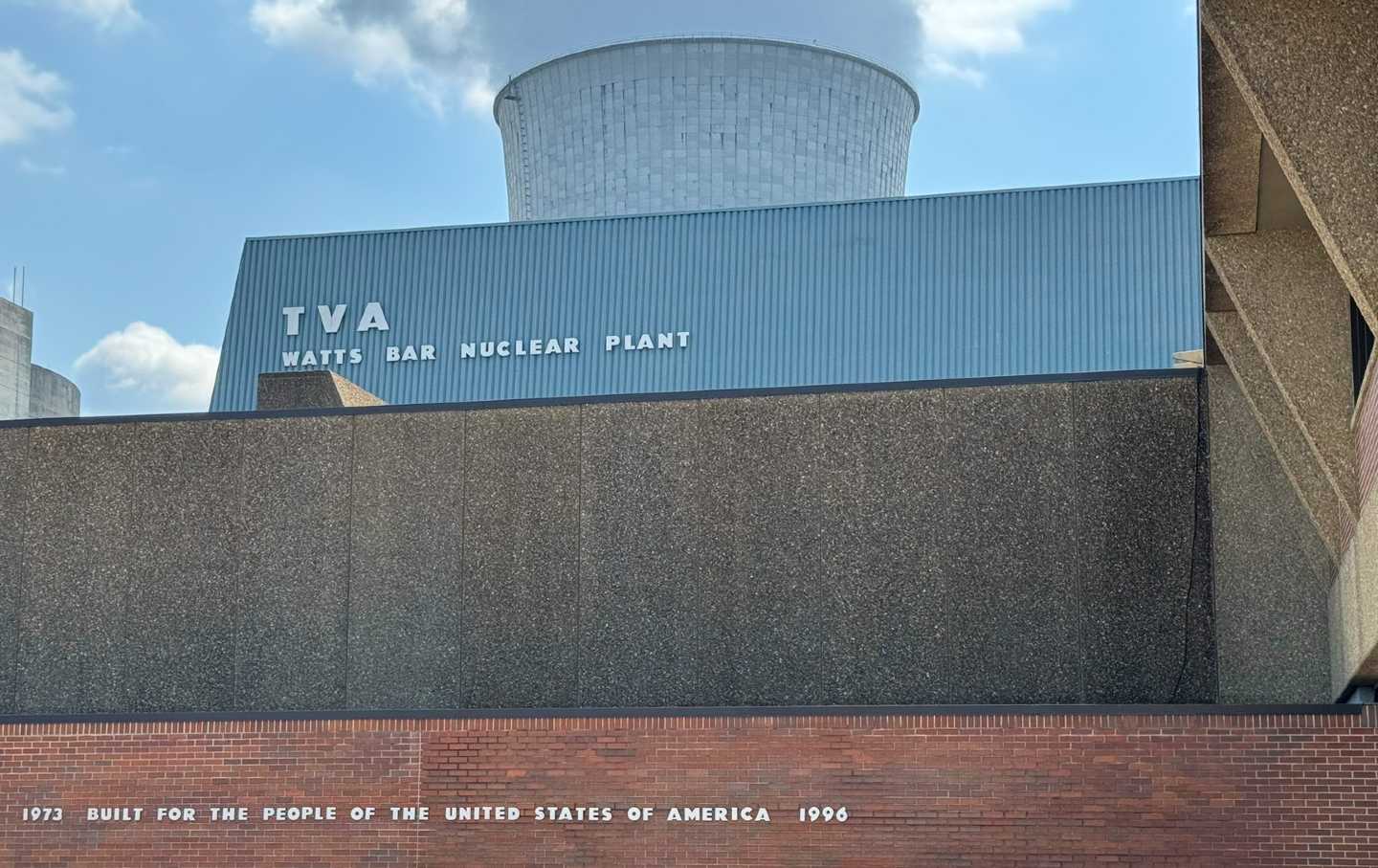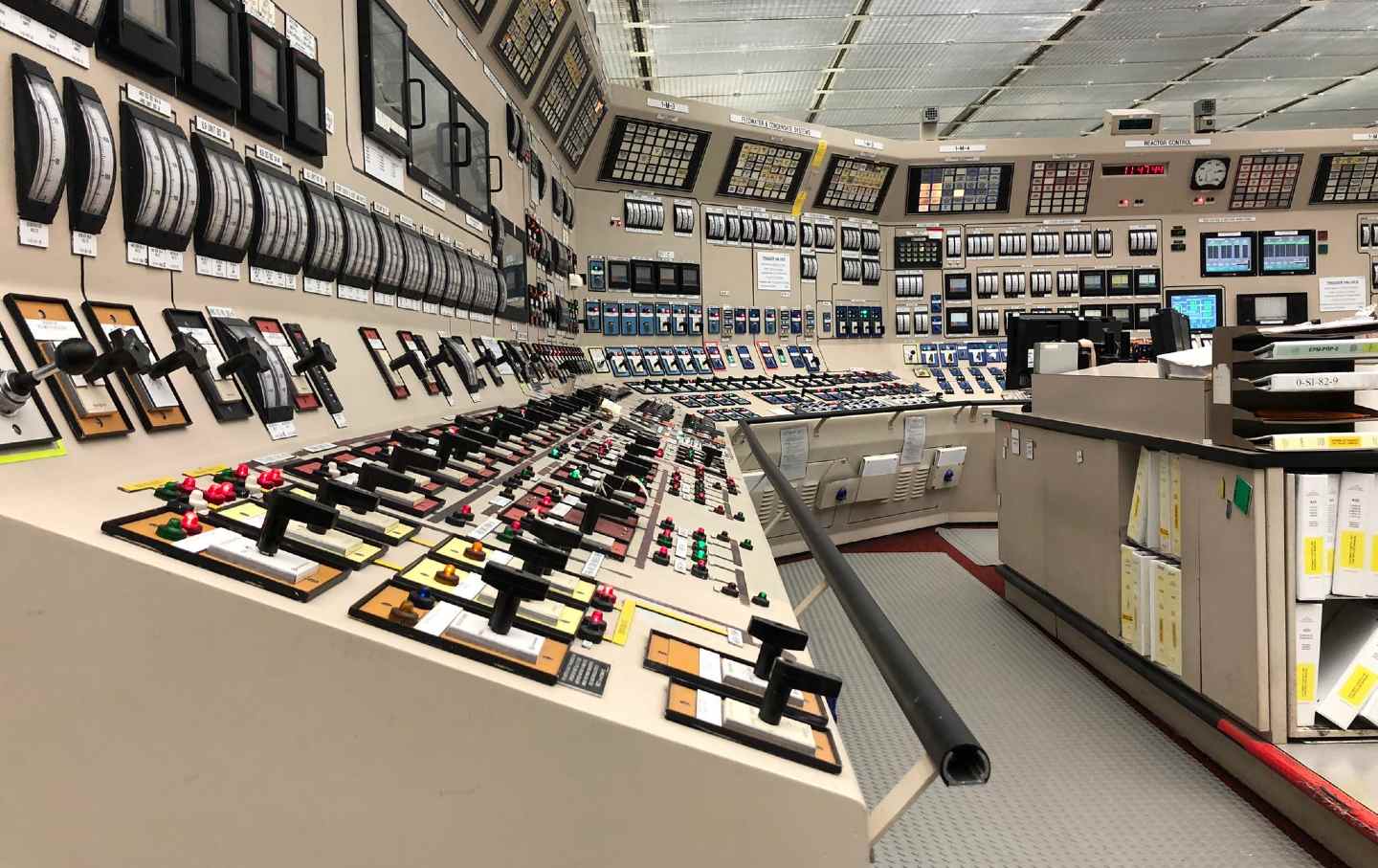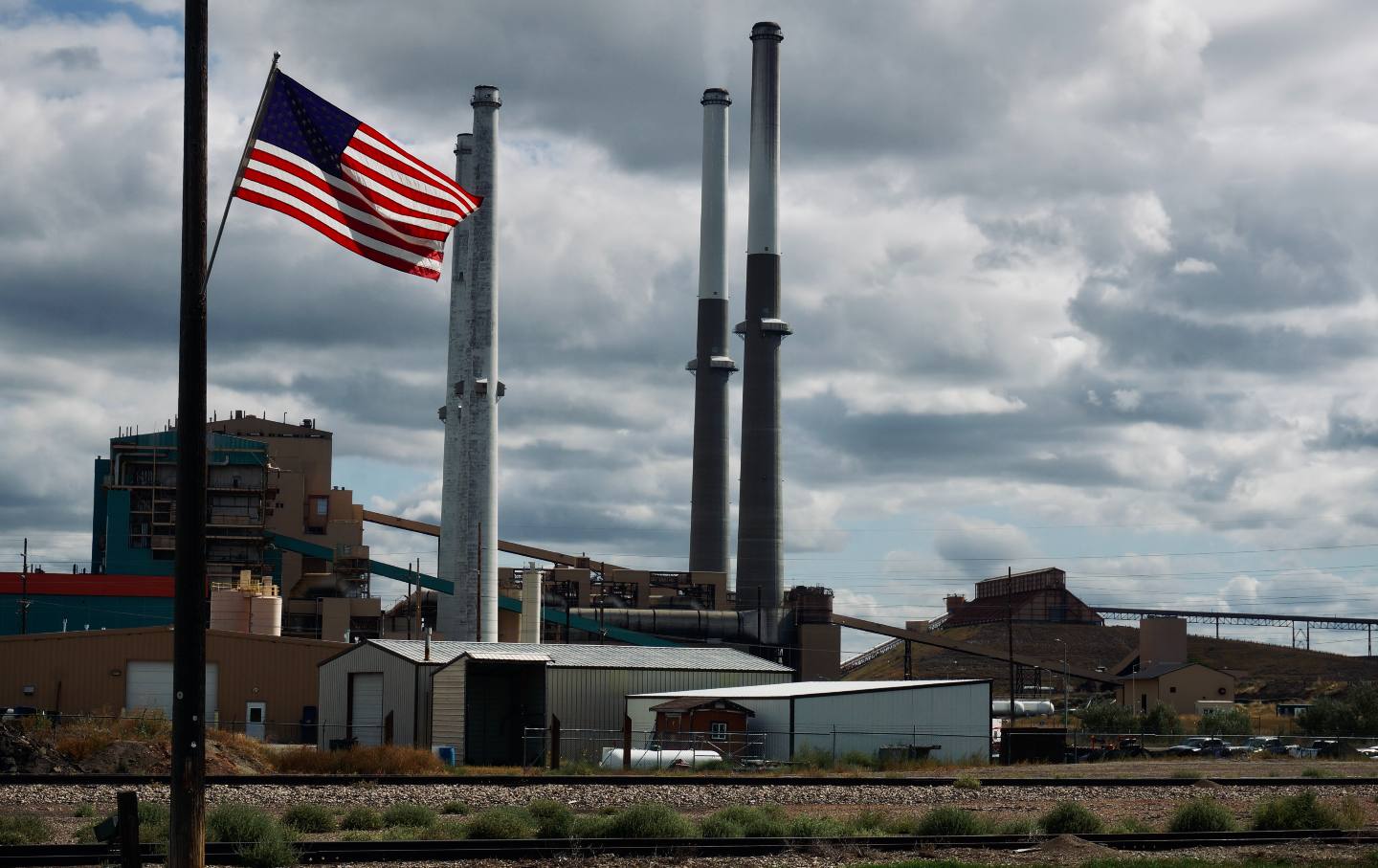The Case for Public Nuclear Power
With additional funding, the Tennessee Valley Authority could provide union jobs, kick-start American industrial production, and help the world go green.

Watts Bar Nuclear Plant.
(Fred Stafford)
As I drove across State Highway 68, a pair of white plumes rose above the lush landscape of Eastern Tennessee. A clearing in the trees revealed their source: the two hulking cooling towers of the Watts Bar Nuclear Plant.
These puffy vertical clouds aren’t greenhouse gasses like carbon dioxide; they’re water vapor. And the owner and operator of the plant isn’t a private company; it’s the Tennessee Valley Authority, an instrument of the federal government set up during the New Deal and our largest public power utility.
The Watts Bar Nuclear site, about halfway between Knoxville and Chattanooga, is enveloped by nature, with an inner core of industrial facilities, brutalist concrete buildings, and the twin cooling towers. A young deer scampered in front of my car, and another had earlier left droppings on a footpath into the plant. “Not many people know this,” the former reactor operator leading my tour dryly joked, “but the deer are part of the security system.”
Almost a thousand people work here, contributing to the production of 24/7 clean energy. At break tables outside the entrance, I saw some of them soaking up the summer sun. Above them was a slogan affixed onto each of the TVA facilities I visited: “Built for the People of the United States of America.”
Thanks to its potential for decarbonization, nuclear energy is more prominent in national policy than it’s been in decades. The Biden administration has thrown the weight of the government behind the technology: subsidies in the Inflation Reduction Act, regulatory reforms in the ADVANCE Act, and extensive engagement with the industry in the Department of Energy. For the first time in the United States, a closed nuclear plant, in Michigan, is being restarted. “To reach our goal of net-zero by 2050,” Jennifer Granholm, Biden’s secretary of energy, recently stated, “we have to at least triple our current nuclear capacity in this country.” But after staggering cost overruns and delays at the most recent nuclear megaproject now complete in Georgia—more than double its $14 billion estimate and seven years late—no companies are ready to build the next one.
In the burgeoning era of decarbonization, the TVA offers an opportunity—as a potential not-for-profit way to kick-start new nuclear energy in the US.
To make this reality, the TVA’s chief nuclear officer told me, it will need to solve a series of political and economic constraints, particularly a glaring budgetary hole. If the TVA moves forward with nuclear energy—and if it and the nation are serious about decarbonizing, it should—will that hole be plugged with federal funding in order to preserve the New Deal institution’s public orientation? Or will it be a new kind of public-private partnership with Big Tech companies like Google, Amazon, and Microsoft, as the nuclear industry has been eyeing?
“I’ll be honest with you,” said Brent Hall, the 10th District vice president of the International Brotherhood of Electrical Workers, about the latter option. “I think that will be the beginning of the end of public power.”
The TVA’s journey to nuclear
Just before arriving at Watts Bar Nuclear, the state highway travels along the top of the old Watts Bar Dam. The dam and its generators, a construction project approved and funded by Congress in 1939, was the TVA’s fifth such public infrastructure project for flood control, river navigation, and cheap electricity. The dam created a reservoir, which is now filled with recreational boats and that has a playground along its shoreline.
Though the TVA’s establishment was part of New Deal experiments to ameliorate the economic and ecological devastation of the Great Depression, the authority quickly took on a new national mission: powering industrial facilities like aluminum smelters with hydroelectric dams as part of the government’s war effort. The revenues from selling electricity to industry also meant lower rates for the growing number of TVA’s residential consumers.
In 1940, the federal government feared a power shortage because it was forecasting a dry year would lower the river levels. The TVA’s directors wrote to Roosevelt and made the case for expansion: “Nowhere in the country can that block of additional electrical energy be provided more rapidly.” The following year, at the government’s urging—and funding—the TVA commenced construction on its first coal-fired plant, the Watts Bar Steam Plant. Now the TVA’s power generation, crucial for war production, would no longer depend on the weather.
In the postwar period, the TVA grew to become the nation’s largest electric utility. An early TVA chairman once claimed that the authority’s dams contained “12 times the bulk of the seven great pyramids of Egypt.” But instead of hydropower it was the TVA’s coal plants, far less constrained than dams, that formed the backbone of the expansion. And once again the needs of the federal government drove the growth: uranium enrichment for the Cold War nuclear arsenal. Beginning with the Manhattan Project, enrichment at federal labs would eventually soak up most of the TVA’s power. In 1955, the TVA started operating its behemoth Kingston coal plant. At the time, it was the world’s largest fossil-fueled power plant.
A decade later, in 1965, the TVA announced plans for its first nuclear power plant. “Nuclear Roars at King Coal” read a Knoxville newspaper headline. The demand from federal labs had been decreasing from its 1957 peak, but the regional demand for TVA power was growing even faster. That growth forecast led the TVA’s directors to kick off an ambitious but organizationally flawed nuclear power program that, by 1975, consisted of 17 reactors planned across seven different sites. TVA directors had assumed that the 1970s energy crisis would drive industries to switch from fossil-fueled energy sources to electrical energy, driving up demand for power. Instead, demand shrank as industries joined households in cutting back on energy to lower their skyrocketing costs. That left the utility with multiple nuclear megaprojects whose power, if the TVA spent the roughly $10 billion needed to complete them, wouldn’t be needed.
Throughout the 1980s, the TVA canceled or put on hold many of these nuclear projects. In the end, it built seven reactors across three sites. The second reactor at Watts Bar Nuclear Plant, for example, came online only in 2016 after its construction lay dormant for decades.
Over the past 20 years, coal power, once a juggernaut in the region, dropped from 60 percent of all electricity in the TVA’s system to only 14 percent. Nuclear has overtaken it as the TVA’s largest source of power, standing at 43 percent last year. Though decarbonization wasn’t the original intent of the TVA’s nuclear program, it has been the result.
But another source of power has played a key role in the TVA’s energy transition away from coal: natural gas. In the same 20-year period, it went from only 2 percent to 34 percent of electricity in the TVA’s system. Like everywhere in the American power grid, the emergence of cheap natural gas in the 2000s offered a straightforward way—far cheaper, faster, and simpler than nuclear plants—to replace coal power. That’s why in recent years the TVA’s giant coal plants like Kingston are being retired in favor of new gas-fired power plants, not nuclear plants.
“We’re not fans of gas plants,” said Hall, the IBEW vice president. “You got 30 people that run it” in contrast to around 300 at a coal plant it might have replaced. “Fortunately, TVA’s worked with us very closely,” he said about the coal workforce, “so nobody’s lost their jobs.”
When it comes to a transition to clean energy, however, Hall has a clear preference: “We’ll take all the nuke plants you want to build! That takes more people than a coal plant!”
Because of all the nuclear power, the TVA ranks as providing the second-lowest share of fossil-fueled electricity among the 10 largest “balancing areas” of the grid—the regions with distinct rules and incentives for electrical resources, each controlled by a single grid operator—behind only the main one serving California. That’s despite the TVA’s gas plants. Environmental groups blast out a different data point about the TVA, though: It’s dead last among the same 10 by share of wind and solar electricity.
Environmental groups argue that the TVA’s choosing gas over renewables to replace coal plants is an outrage. But the claims of cheap renewables heralded by climate advocates—and the renewables industry—only narrowly reflect generation costs in a market-based grid, not total system costs for everything needed to integrate them into grid operations, like transmission connections, available land, and sufficient backup power when weather doesn’t permit. It’s those system costs that a grid operator like the TVA concerns itself with.
The Tennessee Valley is looking at massive new electricity demand thanks to a surge in manufacturing in the South and, according to a recent university study, an expected 22 percent growth in the region’s population by 2050. To meet that growth at the same time as it retires the rest of its coal plants, the TVA is turning to a suite of resources, including gas plants, solar farms, energy storage facilities, and, once again, nuclear power. And this time the nuclear program serves national interests beyond regional ones: kicking the tires of American industrial capacity to build big things.
A return to nuclear
In 2022, the TVA announced its decision to launch a new nuclear program. “Achieving a carbon-free energy future is a shared priority,” TVA CEO Jeff Lyash stated, “and TVA is developing a diverse portfolio of clean energy sources—like advanced nuclear technologies—that will help address this challenge.” The first project in this new program revolves around a new kind of nuclear reactor: GE-Hitachi’s BWRX-300, a so-called small modular reactor or SMR.
“We would potentially be first in the nation” to bring an SMR online, the TVA’s chief nuclear officer Tim Rausch told me. Also competing for first in the nation is TerraPower, a company backed by Bill Gates, which is developing an SMR in Wyoming based on their own design.
The TVA is not taking on the SMR project alone; it’s collaborating with the public power authority of Ontario, Canada; GE-Hitachi,; and a Polish industrial group looking to expand clean power in its own country. The goal of the partnership is to finalize the BWRX-300 reactor design and standardize a plan for how to build, staff, operate, and maintain a power plant based on it. With multiple partners comes more orders along the supply chain and, hopefully, decreases in costs.
The benefits of these smaller reactors, Rausch explained, is that “they bring in a lot more diversity in the way our grid is operated.” Unlike a conventional “gigawatt-scale” reactor that needs transmission system expansions to accommodate it, the SMR could fit more easily within the TVA’s existing system. The SMR can also be operated more flexibly: Taking it offline for maintenance and refueling can be done more nimbly, and its power output can ramp up and down, for example, to balance against sunrise and sunset.
If the project succeeds, the TVA could one day rely on SMRs instead of gas plants for flexible, on-demand power to complement increasing renewables. Both Rausch and IBEW see that as a good thing. Offering so much utility to the grid while emitting no carbon into the atmosphere and no pollutants into local communities is what justifies the substantial cost of building the first SMRs. The TVA’s standardized design for BWRX-300 deployment could become a template that is shared with other utilities: particularly smaller public ones across the United States or even those in developing nations that need clean, 24/7 power for industrialization.
Popular
“swipe left below to view more authors”Swipe →Asked what makes the TVA uniquely suited among American companies looking to develop new nuclear power, Rausch told me that it “bring[s] a wealth of best practices and lessons learned in megaprojects like nuclear plants,” for example, myriad technical matters around permitting, site design, and nuclear safety regulations. Crucially, it also has institutional memory of the mistakes of the past TVA nuclear program.
Put in those terms, it’s a wonder why tapping America’s homegrown nuclear operators and megaproject experts—the ones not beholden to shareholders concerned with stock prices and dividends—hasn’t been at the forefront of the resurgence of industrial policy.

At a ceremony to mark the completion of the two new large nuclear reactors at Plant Vogtle in Georgia, Secretary Granholm declared, “It’s time to cash in on our investments by building more of these facilities.” Each build of the same nuclear design after the “first-of-a-kind” should lower project costs as planners, manufacturers, managers, and workforces learn by doing.
Asked whether the TVA could take on that role of building a large nuclear plant, Rausch said, with a poker face, “our new nuclear strategy is inclusive of all our options.”
Since the TVA announced the SMR project in 2022, he explained, two key factors have changed. The TVA’s electricity demand forecasts have increased further still, thanks in part to new manufacturing, and the nuclear industry has shifted its focus back to large plants like Vogtle after its successful completion and after the termination of the first commercial SMR project, based on a different design, in Idaho last November. Amid rising inflation, the consortium of municipal utilities in the West that were backing the project couldn’t justify to their customers another increase in estimated costs, despite up to $1.4 billion promised in direct federal cost sharing.
One tremendous advantage the TVA has if it does decide to invest in a large reactor: four perfectly good sites, each one frozen in amber since the original nuclear program stalled out. Rausch highlighted the TVA’s 1,200-acre Bellefonte site in particular. It has the water supply, suitable topography, carefully considered seismic conditions, transmission connection, and even cooling towers already in place. “That piece of property becomes more and more valuable as we analyze the demand growth.”
When it comes to a potential large nuclear project, labor unions representing thousands of TVA employees are fully on board. “For us as the union, knowing the need for new demand and the rate at which it’s growing, we see a large nuclear plant as being a viable option for TVA today,” explained Curtis Sharpe, an IBEW international representative working with Hall and a longtime TVA electrical worker himself. They represent about 2,300 full-time TVA employees. “That doesn’t mean taking SMRs out of the picture.” SMRs, he said, “should be the future of nuclear.”
Why not both? That sentiment is echoed by the International Federation of Professional and Technical Engineers, which represents some 2,500 white-collar professionals at TVA. Arguing that it “makes sense that TVA would lead the way on SMRs,” the union’s international president Matt Biggs told me they “fully support TVA moving forward on SMRs and large nuclear alike.” After all, “nuclear is critical in our efforts to meet net zero emissions.”
Down the current path, a first-of-a-kind small modular reactor facility that could be a blueprint for future clean energy worldwide. Down a possible branching path, a next-of-a-kind large reactor facility that activates American nuclear supply chains. And in any scenario, it would be “Built for the People of the United States of America.”
The problem is that somebody needs to fund it.
Funding our public goods
Though Watts Bar Dam and Watts Bar Steam Plant received congressional appropriations from a New Deal and then wartime Congress, Watts Bar Nuclear Plant didn’t receive any taxpayer money. Ever since 1959, when President Dwight Eisenhower decried the TVA as “creeping socialism,” its power projects have been self-financed.
The TVA has been funding its share of the collaborative SMR project by itself—an amount just recently expanded to $350 million. That will pay for finishing the design and applying for a construction permit with the US Nuclear Regulatory Commission. But, unfortunately for the Valley, that money comes from an increase in rates—the prices people and businesses pay for electricity on their monthly bills.
In June, the Department of Energy announced a grant of $900 million available to a winning SMR project. A TVA representative told me it will apply for the grant, but to the government it will be a competitor undifferentiated from private companies like TerraPower.
How much would the SMR project cost, should the TVA ultimately decide to build it, not just plan it? Estimates for the first-of-a-kind project have not yet been disclosed by the TVA and are probably too far out to gauge. But for comparison, the expansion of Vogtle cost $35 billion while a recent gas plant that the TVA built to replace coal—tried-and-true technology, and with a capacity about half the power of the Vogtle expansion—cost it about $1 billion.
To deploy whatever enormous amount of capital is needed, the TVA has one core financial tool in its toolbox: debt. Since Eisenhower cut off the TVA from federal funding, it raises capital for its major power projects by issuing and selling bonds that are slowly paid off, with interest, from electricity sales.
Besides the cost to TVA customers, the tool is not big enough for the job. Federal statute sets a limit on TVA’s debt issuance at $30 billion—an amount that would be worth more than $100 billion today if it had kept pace with inflation—and it has only about $10 billion remaining.
TVA’s chief financial officer John Thomas recently claimed that its debt limit “doesn’t inhibit our ability” to start new nuclear projects. But three different nuclear consultants I spoke to doubted that assertion. The leaders from IBEW and IFPTE did too, but they expressed sympathy for TVA management: Calling for more debt isn’t exactly a popular political position. “They don’t want to ruffle feathers,” Biggs suggested.
There’s another constraint. A 1992 federal statute requires that the TVA plan for the energy resources with the lowest cost—not just in terms of dollars, but also environmental impacts and economic development. Basically, if new nuclear is not the cheapest option for the Valley, then it can’t be built.
“It’s a Rubik’s cube right now,” Rausch said, “trying to figure out how all those pieces come together for us.”
But there’s an easy solution: supplementary funding. That could come from the federal government or the private sector. An example of the latter, Rausch indicated, might be a Big Tech company like Google willing to pay a premium to say its data-center power consumption is zero-emission not just on an annual basis, as with the renewable-energy claims it makes today, but 24/7.
There’s precedent for the public option. The TVA received direct appropriations from Congress to fund its power projects up until Eisenhower. But the private option—a private funding source for a major capital project developed, owned, and operated by the TVA—would be a break from the public power system’s history.
Labor representatives want the public option. Biggs from IFPTE told me, “TVA is a shining gem we should maintain the way it is.”
Hall, the IBEW VP, said the federal government should help the TVA build the next nuclear plant. After all, it would be a tremendous service to national energy and industrial policy. “You think Elon Musk would go to the moon if NASA hadn’t already done it?” Hall asked. “Everybody talks about socialism, but socialism is what fuels capitalism.”
Public power’s political coalition
The labor unions of the TVA have proven to be the TVA’s most important political stewards.
For example, when President Barack Obama floated the prospect of privatizing the TVA in 2013, the annual AFL-CIO convention unanimously passed a resolution to “work with Congress in opposing any effort…[to] move toward selling the TVA to private interests.” They also resisted President Trump’s attempt to sell off the transmission system.
More on Nuclear Power:
Another key element of the unions’ stewardship is to lobby Congress—something that the TVA, as a federal entity, is prohibited from doing. The most significant legislative result in recent years is the TVA’s eligibility for clean energy tax credits in the Inflation Reduction Act, a monumental reversal of precedent. “We took it to the White House that TVA deserves those tax credits just like anybody else,” Hall explained. “They shouldn’t be exempted just because they’re part of the government.” Biggs confirmed that IFPTE, too, lobbied Congress for TVA’s eligibility.
Labor’s advocacy for the TVA contrasts with the other major political constituency, environmental nonprofits who regularly train their crosshairs on the public power authority. The common narrative from the likes of Sierra Club is that the TVA is investing in gas plants instead of solar farms out of a fossil-fuel agenda, not as the satisfaction of any technical or economic constraints. The Southern Environmental Law Center says the TVA is on a “fossil fuel spending spree,” spending billions on new gas plants and pipelines. These environmental groups fail to acknowledge that the TVA is one of the cleanest grid operators in the country; it just arrives at that outcome primarily with nuclear, not solar, power. And with more nuclear power, it could rely less on natural gas, for example, to undergird the integration of more renewables.
Stephen Smith, the longtime executive director of the Southern Alliance for Clean Energy, told me his organization is “not currently supporting TVA building nuclear plants”—nor did it support Watts Bar Nuclear, which actively contributed to TVA’s decarbonization—and “are not in favor of willy-nilly raising the debt limit.” Senior attorney Amanda Garcia of the Southern Environmental Law Center told me they “do not oppose research into unproven technologies like TVA’s proposed small modular reactors” but would only support federal funding with requirements on curbing new gas investments. (The BWRX-300 is based on the proven technology of boiling water reactors that the TVA has operated for decades; it even uses the same fuel.) The Center for Biological Diversity declined to comment for this story.
If the TVA can’t find supplementary funding from the government, it will likely find a private partner. Amazon, Google, Meta, and Microsoft all have data centers powered by the TVA, and all have expressed interest in purchasing nuclear power to meet decarbonization commitments. And thanks to the TVA’s partnership with Ontario Power Generation, which has a head start in construction and whose commitment to four reactors is helping establish the supply chain, the SMR project will almost certainly persevere.
However the TVA manages to secure funding for a new nuclear plant, and no matter whether it’s a small modular reactor or a modern large nuclear plant, it would be a tremendous achievement for clean energy and for public power. But without political support for government funding of TVA’s nuclear program right now—the kind that labor unions demand and environmental lawyers ignore—that project will be the result of private interests muscling their way into public power.
If and when that plant is built, let’s make sure the entrance reads “Built for the People of the United States of America” without needing an addition: “and Google.”
Disobey authoritarians, support The Nation
Over the past year you’ve read Nation writers like Elie Mystal, Kaveh Akbar, John Nichols, Joan Walsh, Bryce Covert, Dave Zirin, Jeet Heer, Michael T. Klare, Katha Pollitt, Amy Littlefield, Gregg Gonsalves, and Sasha Abramsky take on the Trump family’s corruption, set the record straight about Robert F. Kennedy Jr.’s catastrophic Make America Healthy Again movement, survey the fallout and human cost of the DOGE wrecking ball, anticipate the Supreme Court’s dangerous antidemocratic rulings, and amplify successful tactics of resistance on the streets and in Congress.
We publish these stories because when members of our communities are being abducted, household debt is climbing, and AI data centers are causing water and electricity shortages, we have a duty as journalists to do all we can to inform the public.
In 2026, our aim is to do more than ever before—but we need your support to make that happen.
Through December 31, a generous donor will match all donations up to $75,000. That means that your contribution will be doubled, dollar for dollar. If we hit the full match, we’ll be starting 2026 with $150,000 to invest in the stories that impact real people’s lives—the kinds of stories that billionaire-owned, corporate-backed outlets aren’t covering.
With your support, our team will publish major stories that the president and his allies won’t want you to read. We’ll cover the emerging military-tech industrial complex and matters of war, peace, and surveillance, as well as the affordability crisis, hunger, housing, healthcare, the environment, attacks on reproductive rights, and much more. At the same time, we’ll imagine alternatives to Trumpian rule and uplift efforts to create a better world, here and now.
While your gift has twice the impact, I’m asking you to support The Nation with a donation today. You’ll empower the journalists, editors, and fact-checkers best equipped to hold this authoritarian administration to account.
I hope you won’t miss this moment—donate to The Nation today.
Onward,
Katrina vanden Heuvel
Editor and publisher, The Nation
More from The Nation

What Your Cheap Clothes Cost the Planet What Your Cheap Clothes Cost the Planet
A global supply chain built for speed is leaving behind waste, toxins, and a trail of environmental wreckage.

The UK’s Climate National Emergency Briefing Should Be a Wake-Up Call to Everyone The UK’s Climate National Emergency Briefing Should Be a Wake-Up Call to Everyone
The briefing was a rare coordinated effort to make sure the media reflects the science: Humanity’s planetary house is on fire, but we have the tools to put that fire out.

AI Will Only Intensify Climate Change. The Tech Moguls Don’t Care. AI Will Only Intensify Climate Change. The Tech Moguls Don’t Care.
The AI phenomenon may functionally print money for tech billionaires, at least for the time being, but it comes with a gargantuan environmental cost.

Backsliding in Belém Backsliding in Belém
Petrostates at COP30 quash fossil fuel and deforestation phaseouts.

Wake Up and Smell the Oil. Your Nation’s Military Is Hiding Its Pollution From You. Wake Up and Smell the Oil. Your Nation’s Military Is Hiding Its Pollution From You.
A fact all but ignored at COP30.

Trump Promised to Bring Back Coal. This Town Listened. Trump Promised to Bring Back Coal. This Town Listened.
Through executive orders, Congress, and a loyalist cabinet, the Trump administration has delivered big for enclaves of coal country like Colstrip, Montana. But how long can it las...


